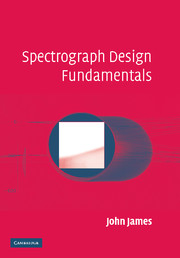Book contents
- Frontmatter
- Contents
- Preface
- Acknowledgements
- 1 A brief history of spectroscopy
- 2 The relevant regions of the electromagnetic spectrum
- 3 Geometrical optics
- 4 Optical aberrations
- 5 Fourier transforms: a brief revision
- 6 Physical optics and diffraction
- 7 The prism spectrograph
- 8 The plane grating spectrograph
- 9 The concave grating spectrograph
- 10 The interference spectrograph
- 11 The multiplex spectrometer
- 12 Detectors
- 13 Auxiliary optics
- 14 Optical design
- 15 Mechanical design and construction
- 16 Calibration
- 17 The alignment of a spectrograph
- Appendix 1 Optical aberrations
- Appendix 2 Wavelengths of spectral lines for calibration
- Appendix 3 The evolution of a Fabry–Perot interference spectrograph
- Appendix 4 The common calibration curve in silver halide spectrophotometry
- Bibliography
- Index
17 - The alignment of a spectrograph
Published online by Cambridge University Press: 02 September 2009
- Frontmatter
- Contents
- Preface
- Acknowledgements
- 1 A brief history of spectroscopy
- 2 The relevant regions of the electromagnetic spectrum
- 3 Geometrical optics
- 4 Optical aberrations
- 5 Fourier transforms: a brief revision
- 6 Physical optics and diffraction
- 7 The prism spectrograph
- 8 The plane grating spectrograph
- 9 The concave grating spectrograph
- 10 The interference spectrograph
- 11 The multiplex spectrometer
- 12 Detectors
- 13 Auxiliary optics
- 14 Optical design
- 15 Mechanical design and construction
- 16 Calibration
- 17 The alignment of a spectrograph
- Appendix 1 Optical aberrations
- Appendix 2 Wavelengths of spectral lines for calibration
- Appendix 3 The evolution of a Fabry–Perot interference spectrograph
- Appendix 4 The common calibration curve in silver halide spectrophotometry
- Bibliography
- Index
Summary
The method described here is suitable for the assembly and adjustment of a Čzerny–Turner type of spectrograph. Essentially similar methods are indicated for other types and mountings.
Alignment is best carried out systematically after the instrument has been installed in its place of work or, if it is newly made, close to the workshop which made it.
The optical alignment
The optical table has a number of holes drilled at the vertices of the mirrors and the grating. Into these holes will normally fit the vertical axle about which the angular adjustments of the optical components are made. If a precision milling machine is available, similar holes can be drilled along the optic path so that alignments can be checked at any time.
An alignment tool (Fig. 17.1) should be made, preferably but not necessarily of metal, which will stand on the optical table with a base extension which will fit these holes. It should carry a vertical disc with a 1mm hole at the height of the optic axis.
Stage 1. A laser beam, adjusted to the height of the optic axis, is made to shine through the centre of the entry slit so that it is parallel to the optical table surface. ‘Parallel’ here means that the light from the laser would be able to pass through the hole in the alignment tool no matter where the latter is placed on the table.
- Type
- Chapter
- Information
- Spectrograph Design Fundamentals , pp. 172 - 174Publisher: Cambridge University PressPrint publication year: 2007



